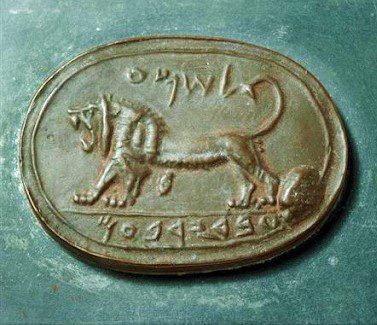Before talking about Schumacher’s Excavations at Megiddo I want to start with Wilhelm II, The German Emperor. On one of his political visits to the Ottoman Empire, came to visit the Holy Land. So The Kaiser started his journey In Istanbul in October 1898; Then he went by yacht to Haifa on October 25th. And in Haifa, he met with the German Templars, at the German Colony, Haifa. As we all know in this journey he also met with Benjamin Theodor Herzl, twice. Once in Jerusalem and the second time was at Mikveh Israel. Due to the visit, the funding for the first German major excavation in the Holy Land was achieved.
Deutscher Palästina Verein
The German Association for the Exploration of Palestine chose Gottlieb Schumacher to head the excavations at Megiddo on its behalf. He was living in the German Colony in Haifa. And already made quite a name for himself as an engineer, surveyor, and architect. Actually, one of his most important projects was the survey of the Golan and Hauran districts, in preparation for the construction of the Damascus-Haifa railway, which branched off from the Hejaz railway at Deraa. In the course of this survey, he produced the first accurate maps of these regions, along with detailed descriptions of the archaeological remains. Also he published since 1886 articles reporting his discoveries in the Zeitschrift des Deutschen Palästina-Vereins.
Gottlieb Schumacher as Archaeologist
When Schumacher took upon himself to head the excavations at Megiddo he was already 46 years old. In fact, he did not have the appropriate experience to conduct such a complicated excavation like Tel Megiddo. In any event, the excavations took place between the years 1903-1905. During those three seasons of excavations, Schumacher had made great discoveries. For example, he unearthed a wing of the Eastern Palace dated to the Israelite Period.
The way Schumacher excavated is very different from the way excavations are conducted currently. In other words, he dug a wide trench that ran north to south. He was able to find tombs dated to the Middle Bronze Age, Canaanite Period. He reached all the way to the Monumental Gate at Megiddo that lead to the South Palace.

GOTTLIEB SCHUMACHER
Gottlieb Was a Gifted Architect and Engineer
His reports are extremely detailed. He made excellent descriptions of the Tel alongside accurate maps showing his discoveries like the fortifications of the Tel. On the other hand, Schumacher did not have the proper training; knowledge, or experience that were crucial for the success of such a complicated, with multiple archaeological layers. Mainly, what is missing in his work is the attention to small details and the distinction between the various components in an archeological dig like the filling of soil; the different stratum of the soil, and so forth.
So his poor understanding of Stratigraphy diminishes considerably his conclusion. Furthermore, Schumacher was the only one that managed the archaeological aspects of the dig. His workers were lacking any basic knowledge in archaeology or in conducting an archaeological dig. So this caused many mistakes in the field, missing important details. And mainly the loss of important information due to the fact that Schumacher, an architect in his training completely ignored entire findings.
Schumacher’s Excavations at Megiddo: The Seal Of Shema
Among Schumacher’s Excavations at Megiddo was especially interesting was the Seal, dated to 788 BCE that was found in the excavations in 1904. The seal depicts a magnificent lion, realistically shown in full in a full-throated roar with its tufted tail erect. The seal has an inscription in Hebrew which says: “Shema, servant of the King”.

THE SEAL OF SHEMA
But who is the king in the year 788 BCE? So Jeroboam II inaugurated the longest reign of a King in Northern Israel in 788 BCE. He ruled over a period of unparalleled prosperity, taking advantage of a lapse in strong Assyrian control of the Levant.
Also, other seals dated from the Iron Age bear this title, an indication that the word ‘servant’ meant actually a high-ranking official of the King of Israel and Judah. Biblical evidence lends further credence to this hypothesis. For example, one of the royal officials listed in 2 Kings 22-12 is the “King servant Asaiah”.

THE THEODOLITE USED BY GOTTLIEB SCHUMACHER IN THE MUSEUM OF THE GERMAN PROTESTANT INSTITUTE IN JERUSALEM
Schumacher’s Excavations at Megiddo: The Conclusions of Gottlieb Excavations
in Schumacher’s excavations at Megiddo Gottlieb was able to distinguish only seven different strata that in his opinion formed the Tel. The stratum just above the bedrock represents the Early Bronze Age. Stratum II & III was dated by him to the Middle and Late Bronze Age. The next stratum represented the Iron Age I, and Schumacher was able to properly identify the layer of destruction there, typical to the end of that period. Stratum V represents the monumental structures from the Israelite Period. For example the palace. Lastly, layers VI and VII reflect later periods.
If you’re want to read interesting archaeological finds you should read my List of Artifacts in Biblical Archaeology.








